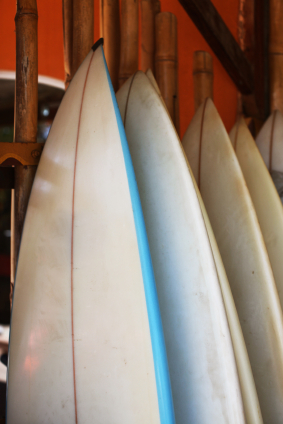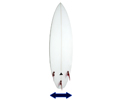Length
Key Factors to Finding the Most Optimal Surfboard Size
The toughest decision when buying a new surfboard can be deciding what the best surfboard size is for you. Weight, height and surfing ability have to be taken into consideration. Many desire to find a surfboard to help string more moves together in the water or at help to advance their surfing abilities. At the same time, one has to be careful to not miss out on too many waves because of the lack of paddling power.
 “I end up asking the guys at the surf shop a ton of questions only to be left with even more questions,” said Sam Brown, a local Newport Beach surfer. “Do I go with a more buoyant material such as EPS and epoxy so that I can surf a smaller board? Should I go with a wider or thicker board so that I can shave off an inch or so in length?”
“I end up asking the guys at the surf shop a ton of questions only to be left with even more questions,” said Sam Brown, a local Newport Beach surfer. “Do I go with a more buoyant material such as EPS and epoxy so that I can surf a smaller board? Should I go with a wider or thicker board so that I can shave off an inch or so in length?”
Different design characteristic such as an egg or a fish allow you to ride shorter than your normal shortboard.
“Is it volume that determines which board is optimal for me?” Brown said.
Those are the questions many surfers have when trying to figure out which surfboard is best for them.
“I’m now getting to the point where I want surfboards measured in cubic volume instead of feet and inches,” Brown said. “Can’t someone just tell me what the most optimal volume for a guy like me who’s 165 lbs, who’s surfed for six years typically in waist to head high waves? I mean, what would be so hard for these surfboard manufacturers and shapers to slap a cubic volume sticker on the board. Then I can look it up on a chart and never have to think twice about it. Sure, I can be safe and buy that bigger board that I’m always comfortable riding but where’s the challenge in that? I want something I can turn on a dime with as little effort as possible.”
Surfers are paying closer attention to finding the right boards the first time around partially due to the higher costs in their equipment.
“If I’m going to spend close to $700 on a brand new board with no return policy, I better not end up sitting in the lineup all day watching the waves roll by and regretting my impulse buy,” Brown said.
Although the surf industry measures surfboards in feet and inches, the question of whether the surfboard manufacturers should also include cubic volume comes up. Perhaps this is a question better asked to a physicist than a surf shop sales guy.
“Volume tells you nothing about buoyancy,” said Lisa Dang, a former Nasa engineer and graduate of MIT and Cal Tech. “A rock can have either very little volume or a lot of volume. It’s going to sink to the bottom of the ocean no matter what. Volume doesn’t contribute to buoyancy, density does. Density is the best measure for buoyancy.”
Different types of foams and materials used in surfboards will vary in density. Expanded Polystyrene (EPS) foam has less density than traditional Polyurethane (PU) foam. However, EPS is combined with additional composites such as Epoxy and fiberglass to help strengthen its structure. The additional materials can add to overall density in Epoxy/EPS surfboards but they are generally less than its PU/Fiberglass counterpart.
Recently new developments in hollow surfboards with carbon fiber composites, such as Aviso, offer surfers an even lighter board.
“In context of a surfboard where you’re comparing two different boards made from the same material, which means the density is about the same, volume make a difference in the sense that it contributes to the surface area,” Dang said.
According to Dang, Surface area of the board is the next best measurement to consider besides density. This is what the surf industry currently uses. Feet and inches in length and width give surfers an idea of the overall surface area.
“The larger the surface area of the surfboard, the more stable it will be. In terms of floatability, more surface area will keep more of the surfer’s body out of the water allowing the board to glide and plane much easier,” Dang said. “A bigger surfer will need a broader base to be stable than a smaller person. However, stability doesn’t equate to maneuverability. Finding a surfer’s optimal stability is not the same as their optimal maneuverability. Finding the most optimal surfboard is a fine balance that will depend on the surfer’s ability.”
If looking to ride shorter than your normal polyurethane board, follow this guide in order of effectiveness:
Guidelines to go shorter:
1. Combat lesser buoyancy from a shorter board with lower density materials. Surfboards made with EPS foam and in some cases, hollow cores are lower in density than your standard polyurethane boards.
2. The next consideration is more surface area. Adding some inches to the width in the nose, mid-section and/or tail can make up a few lost inches of board length.
3. The third consideration is adding thickness to the board. With all else being equal the thicker board will give more buoyancy than the thinner board.
Exact density can be difficult to measure. Without weighing it or knowing how compressed the foam is, it may be impossible to compare densities from a wide variety of surfboards. All boards are made with a combination of different materials such as fiberglass or epoxy and therefore the density is a weighted average of all the material’s density and the foam. Without knowing the amount of each material used, it is impossible to know the exact density. However, you can’t get a rough idea based on the core foam density. You just need to understand the buoyancy of different foams and materials used to make a proper comparison.














8 Comments